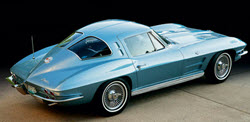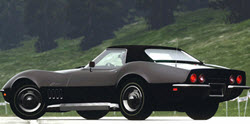The innovations of the Corvette C2 (1963–1967), also known as the Sting Ray.
Introduction to the Corvette C2
The Corvette C2, widely recognized as the Sting Ray, represents a glorious epoch in the automotive world, produced by Chevrolet from 1963 to 1967. This second installment in the Corvette series is lauded for groundbreaking design and remarkable engineering strides. Distinct from its predecessor, the C1, the C2 made notable advancements in aesthetics and mechanical design, marking a noteworthy evolution in the lineage of the Corvette.
Design Innovations
The C2 marked a revolutionary step in automotive styling by taking a significant departure from the first-generation Corvette. The design features that stood out included the uniquely sleek split rear window in the 1963 model year. Though this feature became an iconic design element, it was later removed to improve rear visibility in subsequent models. The Sting Ray’s design was influenced by the earlier concept vehicle, the 1959 Stingray Racer, which had evoked admiration for its futuristic looks.
Incorporating hidden headlamps was another pioneering design innovation. These headlamps pivoted open when needed, enhancing the aerodynamic profile of the vehicle while also providing a clean, distinctive look when not in use. The result was a vehicle with a more aggressive stance and sharper lines, embodying speed and performance even at a standstill. Such features heightened both the visual appeal and functional design of the vehicle.
Chassis and Suspension Improvements
Beneath the captivating exterior, the C2 housed several mechanical advancements that redefined performance and handling capabilities. One of the major improvements was the introduction of an independent rear suspension setup. This replaced the less sophisticated solid axle configuration used in previous models, allowing the C2 to achieve superior handling dynamics and significantly enhanced ride comfort. This development was pivotal in transforming the Corvette into a true sports car capable of competing on the international stage.
The chassis of the C2 was designed with a shorter wheelbase than its predecessor, which contributed to its nimble performance. A redesigned frame with boxed rails was introduced, increasing structural rigidity while reducing frame flex. Such engineering enhancements ensured the C2 was not only faster but also more precise and enjoyable to drive.
Engine and Performance
The power under the hood of the C2 was as striking as its exterior. Multiple engine options were available throughout its production run, catering to varied performance appetites. Starting with the 327 cubic inch V8 engine, the C2 could deliver impressive power. However, enthusiasts’ focus often shifts to the introduction of the 427 cubic inch big-block V8 in the later years, which offered tremendous power and speed, meeting the American clientele’s growing thirst for high-performance sports cars.
Some C2 models were equipped with the innovative Rochester fuel injection system, another testament to Chevrolet’s commitment to performance optimization and efficiency. This system allowed for incredible performance boosts, transforming the driving experience and establishing the C2’s reputation as a powerful machine on the road.
Racing Credentials
While the C2 thrilled everyday drivers, it also carved out a niche in the racing world. The mid-1960s saw the emergence of the Grand Sport variant, designed under the secret direction of Zora Arkus-Duntov, the illustrious chief engineer at Chevrolet. Despite the limited number of units produced, this high-performance iteration demonstrated the C2’s potential to compete with formidable European sports cars, further elevating its status within motorsport circles.
The C2 was not merely a showpiece but a functional and competitive presence on racing circuits, showing that American engineering could compete with international counterparts. The creation of these high-performance models underscored Chevrolet’s desire to push the limits of engineering and design, making the C2 an influential player in motorsport despite its limited racing production.
Conclusion
The Corvette C2 stands as a remarkable chapter in American automotive history, blending aesthetic brilliance with profound engineering innovation. It not only redefined the Corvette’s image as a luxury sports car but also set new standards for performance and design in the industry. The impact of the C2 resonates through the decades, with its combination of visual, mechanical, and racing accomplishments solidifying its place as a prestigious emblem of American automotive excellence.
The Sting Ray’s pioneering contributions laid a foundation upon which successive models of the Corvette would build. This model’s distinct style, advanced engineering, and significant motorsport accomplishments ensured its place in history as a revered sports car. Those interested in deeper insights into the C2’s history and innovations can explore reliable automotive resources such as Hagerty and browse through specialized automotive publications for comprehensive information.



